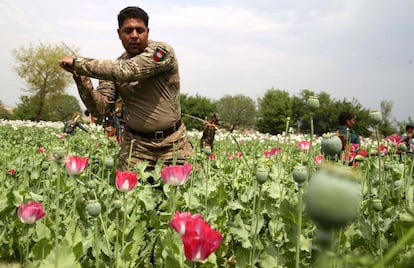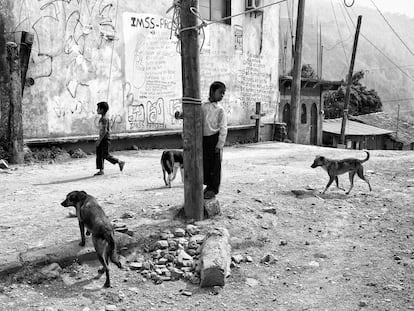The drastic drop in poppy cultivation in Afghanistan has opened a gap for fentanyl in Europe
The European Drug Monitoring Center warns of the risk that synthetic opiates could make up for a hypothetical shortage of heroin on the world market


The poppy is one of the bases of Afghanistan’s economy. The ban on cultivating it by the Taliban, who regained power in 2021, has led to a drastic drop in the number of acres of poppy fields from 575,755 to 26,687. The latest report from the European Drug Monitoring Center warns of the risk that a possible lack of global supply will be replaced with “more harmful synthetic opiates, such as fentanyl derivatives or nitazenes.” Afghanistan produces 80% of the world’s opium, according to the monitor.
“We have no indication that there are synthetic opiates in Spain, but we are all watching with bated breath,” says the government delegate for the National Plan on Drugs, Joan Villalbí. The European report has also landed on their desk, and they have studied it in detail. “The Taliban announced that they would ban opium cultivation. We didn’t know if it would be for real or just for show. Now we have the first warnings that it could be happening,” says Villalbí. The document also points out another risk that comes from the lack of drugs: an increase in “polysubstances” among heroin users.
“It is a window of opportunity,” admits Barcelona’s chief investigative commissioner Ramon Chacón. “They call it the chaos theory: if poppies are not grown in Kabul, thousands of people will die in Europe,” he says, about the consequences that a hypothetical heroin shortage would have on European markets, with consumers who would move on to more dangerous alternatives. But he insists that the data so far refute that this scenario is immediately looming over Europe.
In the last six years, the police have seized 379 grams of fentanyl, according to data from the Intelligence Center against Terrorism and Organized Crime (CITCO). And the majority (291 grams) were confiscated in a single raid in the port city of Ceuta (Spain) in 2018.
Experts also point out that heroin derived from opium produced in Afghanistan has a long journey before it arrives in Europe. “The drugs take a long time to arrive,” says Chacón, which means that the feared shortage has not yet occurred. It is a vision shared by the state director of Energy Control, Claudio Vidal, who specializes in drug analysis: “You can still live for a while on the stock that is already in storage.” Vidal adds that so far they have not found traces of the dreaded synthetic opiates either in their task of analyzing what is consumed both recreationally and in supervised drug consumption rooms. “No one has provided solid data to confirm the presence” of fentanyl or other derivatives in Spain.
Before the actual discovery of the drugs, other elements would allow it to gain a foothold in the market. “The price and purity of heroin would be prior indicators,” says Chacón. Given the shortage of heroin, the cost per gram would increase, and its quality would decrease, it would be more cut with other substances.
Villalbí, however, does not rule out the real risk that, if Afghanistan does not grow opium poppies, the production of synthetic opiates will be carried out “in any of the surrounding countries along the heroin route.” And he warns about a product that requires other chemical elements that are mostly produced in China.
Commissioner Chacón disagrees, saying that the process of manufacturing synthetic opiates is difficult, and must be very measured so as not to kill the consumer right away. “It is not so easy to have the knowledge. It is organic chemistry, and molecularly it is difficult,” he says. In his opinion, it would be more plausible for other countries close to Afghanistan, such as India or Kazakhstan, to take over the much simpler cultivation of poppy fields. Last year, the number of poppy-growing acres in Myanmar overtook Afghanistan’s, according to the report by the European Drug Monitoring Centre.
The police expert points out other elements that also make the arrival of these drugs difficult. The first, the little interest in them shown by powerful criminal organizations, which are focused on supplying other drugs, such as hashish, or marijuana, both in “cycles of growth.” “They don’t need to” because they are already making huge profits.
The commissioner also mentions the “rumor” that comes to the police from time to time, that that cocaine might be cut with fentanyl. The market, he indicates, is in a process of “global fragmentation” with more outsourced production processes, but there is also more cocaine than ever, due to the increase in acres under cultivation in Peru and Colombia. “There is no point in cutting it with fentanyl. And we would find it in the analyses,” he explains. “Cocaine has purity rates that have never been seen before,” agrees Vidal, regarding what his analyzes find.
Extreme growing conditions
Another thing, the police commissioner points out, is that the Mexican cartels, which supply the United States, decided to cover a possible demand in Europe too. But he counterpoints with another element that, in his opinion, can end the threat. How long will the Taliban maintain the veto? “Afghanistan no longer has aid from the IMF or the World Bank,” he says. In addition, the country is suffering from drought. “The fields of fruit tree crops are decreasing more and more because it is not profitable,” he adds. The opium poppy, on the other hand, can withstand more extreme conditions. The ban has had a devastating effect on the country’s economy, with a loss of more than $1 billion for farmers, according to the U.S. Institute of Peace, an independent agency.
And if all else fails, and synthetic opiates finally do enter the European market, those involved in the war on drugs are clear that it would be detected immediately. “You would know right away because the main risk associated with fentanyl is overdose,” recalls Claudio Vidal, from Energy Control. And in many cases these overdoses lead to death. “We are looking at it very carefully,” insists Villalbí, from the National Drug Plan, regarding the monitoring of all the indicators that would demonstrate the arrival of the dreaded fentanyl, which is causing havoc in the United States. In this scenario, Chacón considers that cases of nitazene abuse, which have already been found in Europe, have “higher numbers” than fentanyl. The Health agencies of the United Kingdom, France, and Ireland have issued recent but specific alerts of overdoses due to this type of synthetic derivative, with devastating consequences for health. In any case, Chacón warns, if synthetic opiates reach Europe, “it will be a global phenomenon.”
Sign up for our weekly newsletter to get more English-language news coverage from EL PAÍS USA Edition
Tu suscripción se está usando en otro dispositivo
¿Quieres añadir otro usuario a tu suscripción?
Si continúas leyendo en este dispositivo, no se podrá leer en el otro.
FlechaTu suscripción se está usando en otro dispositivo y solo puedes acceder a EL PAÍS desde un dispositivo a la vez.
Si quieres compartir tu cuenta, cambia tu suscripción a la modalidad Premium, así podrás añadir otro usuario. Cada uno accederá con su propia cuenta de email, lo que os permitirá personalizar vuestra experiencia en EL PAÍS.
¿Tienes una suscripción de empresa? Accede aquí para contratar más cuentas.
En el caso de no saber quién está usando tu cuenta, te recomendamos cambiar tu contraseña aquí.
Si decides continuar compartiendo tu cuenta, este mensaje se mostrará en tu dispositivo y en el de la otra persona que está usando tu cuenta de forma indefinida, afectando a tu experiencia de lectura. Puedes consultar aquí los términos y condiciones de la suscripción digital.
More information
Últimas noticias
Most viewed
- Sinaloa Cartel war is taking its toll on Los Chapitos
- Oona Chaplin: ‘I told James Cameron that I was living in a treehouse and starting a permaculture project with a friend’
- Reinhard Genzel, Nobel laureate in physics: ‘One-minute videos will never give you the truth’
- Why the price of coffee has skyrocketed: from Brazilian plantations to specialty coffee houses
- Silver prices are going crazy: This is what’s fueling the rally










































